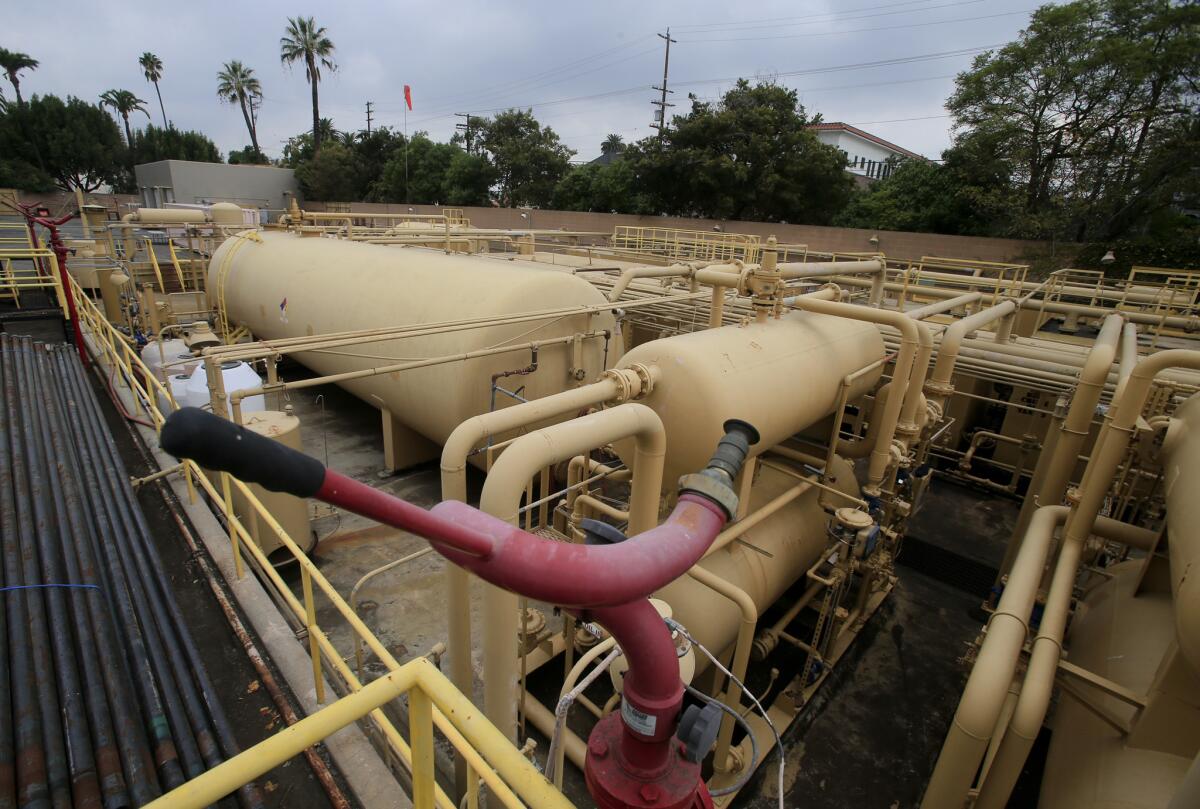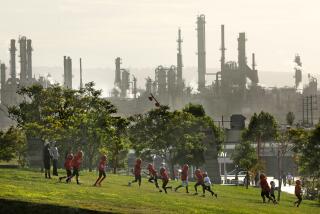Southern California air board puts new restrictions on urban oil fields

Allenco’s oil pumping facility in University Park is shown in 2013.
Urban oil fields in Southern California must improve the way they control odors and respond to complaints from nearby residents under new rules adopted Friday by air quality officials.
The regulations approved on an 11-2 vote by the South Coast Air Quality Management District board come after a surge of complaints in recent years over noxious fumes in South Los Angeles, Huntington Beach, Whittier and other communities where oil production facilities operate near homes and schools.
The highest-profile case has been Allenco Energy Inc., the oil field in the University Park neighborhood near USC whose foul emissions prompted hundreds of complaints of headaches, nosebleeds and respiratory problems after it ramped up production five years ago.
The South Coast air district cited Allenco for 18 violations before the company voluntarily suspended operations at the site in November 2013. But community groups complained that the air district and other oversight agencies took little action to stop the violations.
The air district says the rules will force the oil industry to address foul odors before they become a public nuisance.
Under the regulations, oil field operators must adopt new odor-control measures and post signs in English and Spanish with instructions on how to report odor complaints, among other requirements. Well operators with ongoing odor issues will have to submit a plan to fix the problem.
Facilities within 1,500 feet of homes, schools and healthcare facilities would face more stringent requirements. Operators will have to submit reports on the cause of any confirmed release of odors, oil mist or droplets. In some cases, they will have to install monitoring systems to alert them when leaks and other problems occur.
The regulations will apply to as many as 240 facilities operating more than 4,000 onshore oil and gas wells across Los Angeles, Orange, Riverside and San Bernardino counties.
Industry groups had been fighting the odor-control regulations, saying they unfairly single out oil and gas operations. But their opposition evaporated Friday after an amendment by Air Quality Management District board member Clark E. Parker Sr. Under his motion, operators will have to conduct daily inspections of well equipment only within 100 meters -- or 328 feet -- of homes, rather than 1,500 feet as originally proposed.
The last-minute changes angered environmentalists and community activists.
“AQMD is weakening the rule to provide more protection to the oil industry than to the community,” Bahram Fazeli, policy director for the environmental justice group Communities for a Better Environment, said at Friday’s public hearing.
Barry Wallerstein, the air district’s executive officer, said the changes were minimal and that the rules remain the most stringent in the nation, adding, “these are leading-edge controls for urban oil fields.”
Air quality regulators also revised rules adopted in 2013 that require companies to notify residents and report the chemicals used during drilling, hydraulic fracturing, acidizing and other well-stimulation techniques.
Operators will now have to give 48 hours’ notice of such activities instead of 24, among other changes.
Concerns over air emissions from oil wells have emerged across Southern California over the last few years as production has increased at sites in some residential neighborhoods.
An air district review found Allenco generated by far the most complaints in the region, with more than 250 logged since 2010. An Angus Petroleum Corp. facility surrounded by homes in Huntington Beach had more than 100 complaints. Another oil field near USC, the Freeport-McMoRan site on Jefferson Boulevard, had 15 complaints.
About 1.7 million people in the Los Angeles Basin live within one mile of an active oil or gas well, and more than 32,000 reside within 328 feet, where air toxics can pose risks to human health, according to a July report by the California Council on Science and Technology.
The state-commissioned report recommended an epidemiological study of people living near oil production sites and rules limiting how close the operations can be to homes and schools.
Twitter: @tonybarboza
ALSO:
California Senate acts to ban use of plastic microbeads by 2020
L.A. mayor defends crime-fighting efforts as activists call for anti-violence summit
Venice Beach swimmer dies; hazardous conditions forecast for Labor Day weekend
More to Read
Sign up for Essential California
The most important California stories and recommendations in your inbox every morning.
You may occasionally receive promotional content from the Los Angeles Times.










